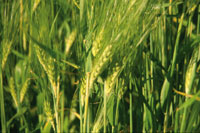
Features
Agronomy
Diseases
Tillage system and cropping sequence
Effects on common root rot of barley.
October 17, 2008 By Top Crop Manager
Effects on common root rot of barley.
As conservation tillage systems and extended rotations with oilseeds and pulse crops become more widespread, growers are seeing shifts in disease issues. These more popular agronomic practices are having an effect on the frequency and impact of various cereal root and crown diseases caused by pathogens that include Cochliobolus sativus, the most common root rot pathogen in western Canada, and several fusarium species. Researchers are trying to determine the effects of different tillage systems and cropping sequence on common root rot of barley.
 |
| Tillage and rotations can affect root rot infestations. Photo Courtesy Of AAFC. |
Dr. Myriam Fernandez, plant pathologist at the Agriculture and Agri-Food Canada (AAFC) Research Centre in Swift Current, has conducted several related studies during the past several years on both barley and wheat root and crown diseases in eastern Saskatchewan. “Although C. sativus is the predominant pathogen causing common root rot in barley in Saskatchewan, we also found a variety of fusarium pathogens. We found and confirmed that the same fusarium species that affect barley heads can also be found in barley roots,” explains Fernandez. Also, similar agronomic practices affect fusarium levels in heads and roots. The main fusarium species isolates, which can cause fusarium head blight (FHB) in barley, include: F. graminearum, F. avenaceum and F. culmorum.
FHB in barley started to spread on the Canadian prairies about a decade ago, with eastern Saskatchewan one of the areas most affected under the right conditions. Drought conditions in recent years have reduced the incidence of FHB infections. However, fusarium pathogens continue to be isolated in roots and crowns. “Because fusarium infections in underground plant tissue are less affected by environmental conditions than spike infections, they may also contribute to the maintenance of inoculum in years not conducive to FHB development, further spreading this disease across the prairies,” she says.
Fernandez and her research team set out to determine the impact of agronomic practices on fungal populations associated with root rot of barley. From 1999 to 2001, 137 barley crops were sampled in eastern Saskatchewan for severity and percentage isolation of various fungi. The researchers tried to separate the effects of tillage system from the effects of crop rotation, particularly with non-cereal crops. The barley root rot study has just been published in Crop Science Journal in collaboration with Bob Zentner, Dave Gehl and Ron DePauw.
The research results showed that under conventional tillage and the use of summerfallow, the levels of C. sativus increased but generally decreased the levels of fusarium species. However, under reduced tillage systems that include herbicide applications and rotations with non-cereal crops, the opposite conditions occurred, with increased levels of fusarium species and lower levels of C. sativus found
in barley crops. Previous research showed similar results in wheat crops in eastern Saskatchewan.
“Overall, fusarium species were most affected by the previously grown crops and were more common in barley grown after a non-cereal than a cereal, and after two non-cereals or a non-cereal alternated with summerfallow in rotation.” Although the levels of fusarium infection remained at lower levels than C. sativus, increases in populations of F. avenaceum and F. graminearum, especially in areas with higher disease pressure than where the present study was conducted, may cause greater development of not only crown and root rot, but also spike infections in subsequently grown cereal crops.
Generally, the worst rotations for increasing root rot pathogens were two non-cereal crops prior to barley. F. avenaceum is the main pathogen and all pulse crops are especially susceptible, including peas, lentils and chickpea. Therefore, growers may want to pay careful attention to their rotations if they are experiencing significant problems with root and crown rot.
Fernandez emphasizes that these results are not intended to discourage growers from using these popular agronomic practices, including conservation tillage and rotations with non-cereals. “On the contrary, we are hoping to help growers find a way to manage these diseases and decrease those levels of fungal pathogens
without abandoning these good practices that are good for the soil and good for the pocket book.”
Related studies try to find more answers
Fernandez has also launched a new study in collaboration with Vladimir Vujanovic of the University of Saskatchewan on barley and wheat root rot to follow-up on some interesting findings from the previous studies. Some fusarium species are common soil saprophytes. Some of these appear to have antagonistic capabilities against F. graminearum and F. avenaceum, which agrees with previously published work in Europe and the US.
“Preliminary observations show that the levels of some of the saprophytic fusarium species are higher under conventional tillage and summerfallow, which is the rotation where some of the fusarium pathogens are the lowest,” explains Fernandez. “We would like to see if increased levels of saprophytic fusarium under reduced tillage systems could potentially reduce the levels of fusarium pathogens.” This research is in the very early stages, but is another effort by researchers to find ways to help growers to continue with their popular and more profitable systems without increasing disease levels.